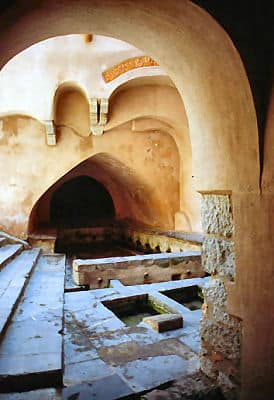Cefalù, a beautiful seaside town in the province of Palermo, is characterized not only by a picturesque and unmissable waterfront, but also and above all by a lot of history and culture. Among the most characteristic and vivid examples of its richness, an unmissable and curious stop is the Medieval Washhouse.
How to get to the medieval wash house in Cefalù
To reach Cefalù’s medieval wash house, a place dense with history and old-world charm, it is necessary to go past the beach and-going through some inner alleys-to arrive at Via Vittorio Emanuele. It will therefore be sufficient to walk down the street to the Martino Palace, which is of late Renaissance age and style. Nearby there, also along Vittorio Emanuele Street, a small staircase called “a lumachella,” made of lava stone, descends right down to the washhouse, now covered along with the Cefalino River after work was carried out in the 17th century. Not far away, the majestic Cefalù Cathedral can be visited.
The legend of the Cephalin River
Water from the Cefalino River, which runs through Cefalù and at which the local washerwomen washed clothes, is conveyed into the washhouse. The river is named in an inscription on the right side of the entrance to the washhouse itself: “Here flows Cephalino, more salubrious than any other river, purer than silver, colder than snow.” The legend of its origins-full of romantic and poignant cues- has it that the river that runs through Cefalù and its washhouse was born from the unceasing tears of a nymph who regretted killing her beloved who had betrayed her.
What to see in Cefalù: the medieval wash house
The structure of the medieval washhouse-with water still flowing, pouring into the twenty-two cast-iron mouths, fifteen of them depicting lion heads-recreates an evocative atmosphere from the outset. The tourist’s imagination is immediately stimulated, and it almost seems as if one can hear the washerwomen of days gone by singing as they rubbed and washed their cloths in the river beyond the entrance arch (of Arab architectural inspiration).
All these elements-from the archway above the entrance to the lava stone of the snail staircase that descends from the street to the wash house, to the cast-iron lion mouths where the water flows-make the place not only historically and culturally attractive, but also ideal for a short refreshing stop while moving around Cefalù.
Especially in the summer months, in fact, Via Vittorio Emanuele and the street known as “the river” can be really hot to walk down: this does not detract from the fact that it is really worth it, just to get to the wash house and the nearby stages of the small harbor and the wonderful cathedral square.
The work over time
It is difficult to determine exactly and precisely at what historical moment the wash house in the village of Cefalù was built: what is certain is that it is an admirable all-Sicilian example of medieval hydraulic engineering. What is known is that in modern times, in 1514, the wash house was demolished and rebuilt in a more backward position, referring to the city walls. Moreover, a century later, around 1600, it would have been covered: in fact, previously the Cephalino River flowed open at that point, while now the washhouse is underground. Further restoration work (aesthetically and hydraulically) was conducted in the 20th century and completed in 1991, when the structure was restored and made visitable today by any tourist in search of a testament to the medieval places and life of the Sicilian island.

